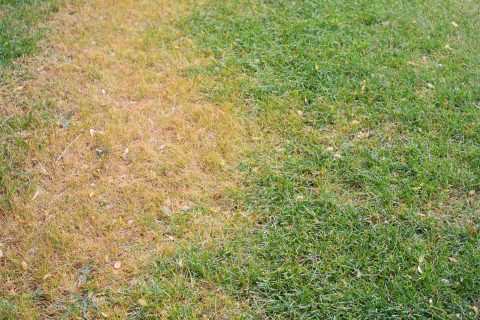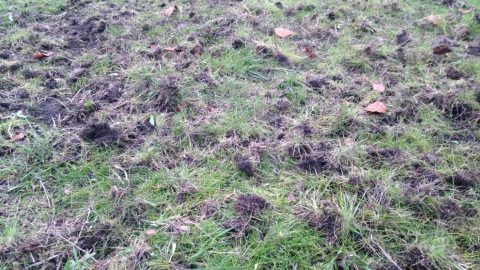
Did part of your lawn die out this summer? Fall is the time to improve lawn health.
This summer broke records (again) for heat and drought. How did your lawn fare?
If your lawn is looking brown and unhealthy, give it some loving care. Fall rains are returning. Now is a good time to assess your lawn care practices and take steps to improve lawn health.
Watering
Did you water your lawn this summer? Ignoring your lawn all summer will make it thin and unhealthy, with bare spots where it has died out. This will make it easier to weeds and moss to invade.
You may be able to reduce watering in areas that don’t see much traffic. But they still need occasional water. Give your lawn an inch of water at least every few weeks to keep it alive.
Next year plan to water your lawn enough to keep it alive and healthy.
Mowing
Your lawn will be healthier if your mowing height is 2-1/2 inches or more. Your roots will grow deeper, and a taller lawn shades out weeds. It also holds up better to drought and damage.
Improve lawn health by raising your mower blades.
Fertilizing
The most important time to fertilize is September. This is when grass plants are building roots for next year’s growing season.
Use organic, slow-release fertilizers. They feed your lawn slowly over time. They also add organic matter to the soil, increasing the biological activity. This helps keep your lawn healthy.
Mulch mowing and top dressing with compost also add organic matter and nutrients to the soil.
Our lawn care program focuses on soil biology to improve lawn health. We apply organic fertilizer a few times a year. We may also add lime or micro-nutrients.
Contact us to find out how our natural lawn care services can help you grow a beautiful, healthy lawn.
Aeration and overseeding
Fall is a great time of year to aerate and overseed to improve lawn health.
Mechanical aeration removes small cores a few inches deep from the soil. This reduces soil compaction. It also helps air, water and fertilizer reach the roots, stimulating growth.
It is best to combine aeration with overseeding to fill in thin spots. This thickens the lawn, so weeds and moss have a difficult time getting established.
Planting grass in fall’s cooler air allows the seeds to grow without drying out. You will need to water initially. The seeds should show shoots in about 10 days if properly cared for.
In Harmony offers aeration and overseeding services in spring and fall. Contact us if you would like to schedule a visit to your lawn.
Sunshine
Lawns need a minimum of four hours of direct sun each day. Your lawn will grow poorly in shade. Consider planting shade-tolerant ground covers and other plants. Or thin trees that are shading the lawn so it gets more sunlight.
We can help you with tree thinning and with lawn alternatives for shade. Contact us if you would like to talk about pruning or shade-friendly plantings.

Birds and animals may tear up your lawn looking for chafer beetle larvae.
Chafer beetles
Does your lawn have areas where the soil has been churned up by birds, raccoons or other animals? They may be looking for the European chafer beetle.
This is a serious lawn pest. If you think you may have chafer beetles, give us a call. We will confirm out to confirm it and report it to the Washington State Department of Agriculture. We can help improve lawn health so your lawn will recover from the damage.
Read more about the chafer beetle in our post from last spring.
Video tips
Watch our YouTube Natural Lawn Care playlist for tips on fall lawn care. Here are direct links to a few videos:
- Natural Lawn Care: Aerating and Top Dressing
- Natural Lawn Care: Fertilizing
- Natural Lawn Care: Soil Sampling
- How to Sharpen a Lawn Mower Blade
